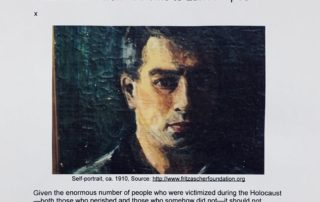Rachel Stern2018-12-03T16:21:23-05:00January 12th, 2017|Exhibitions, Past Exhibitions|
The worldwide first Fritz Ascher Retrospective is on view at the Kunstsammlungen Chemnitz - MUSEUM GUNZENHAUSER from March 5 to June 18, 2017. (website link) The main focus of the presentation at the Kunstsammlungen Chemnitz - MUSEUM GUNZENHAUSER is on the artist's important early masterworks like "Golgatha" (1915), "Bajazzo and Artists" (ca. 1916) and "The Tortured" (ca. 1916). For the first time ever, Fritz Ascher’s “Golem” from the collection of the Jewish Museum Berlin will here be reunited with other works the artist created between 1913 and 1933. The Kunstsammlungen Chemnitz is home to an important collection of German Expressionism, dominated by artwork of the locally founded Expressionist group Brücke and especially Karl Schmidt-Rottluff, who grew up in Chemnitz, along [...]
Newsletter #3 October 2015
Rachel Stern2016-12-08T00:03:24-05:00October 25th, 2015|Newsletter|
Best wishes to our Jewish friends in 5776! May it be a good and peaceful year for everyone. EXHIBITION A few days ago, the exhibition "»Making Amends« Compensation and Restitutions in a Divided Berlin" was opened at the Gedenkstätte deutscher Widerstand in Berlin. The exhibition, which was organized by a team of the Aktives Museum and the Gedenk- und Bildungsstätte Haus der Wannsee-Konferenz Berlin is celebrating the 70th anniversary of the liberation from the Nazi terror regime with this in-depth examination of the practice of restitution after 1945. Especially in Berlin, where during the Cold War two completely different concepts of restitution existed side-by-side, their political framework and its consequences for the restitution procedures can be demonstrated like nowhere else. [...]
Rachel Stern2021-02-25T04:48:57-05:00January 18th, 2015|Select Press Coverage|
Fritz Ascher: from Golems to Landscapes by Ori Z. Soltes Given the enormous number of people who were victimized during the Holocaust—both those who perished and those who somehow did not—it should not surprise us that, as time goes by, narratives still continue to emerge reflecting the varied experiences of these victims and their tormentors or saviors. Among these there are many artists—artists, like Felix Nussbaum (1904-1944), who were producing high-level work, and others less skilled—who did not survive but left behind bodies of work that provoke the question: what if? Had these artists not been destroyed by the Nazis, what might they have accomplished and what songs of praise might art historians now be singing about them? There [...]





